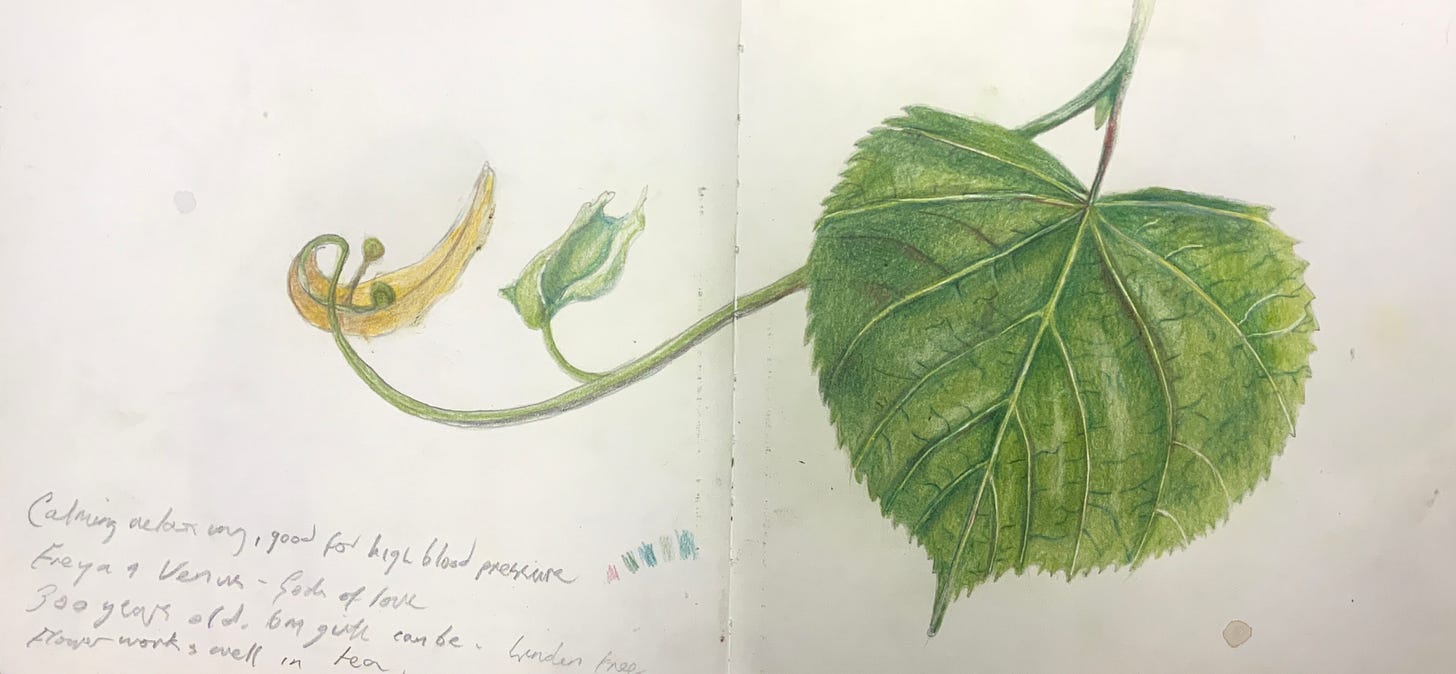Lime trees can be seen lining many of London’s Victorian streets, often heavily pollarded to keep them smaller than they would naturally grow. For years I wondered why I never saw limes on these lime trees; it seemed I was missing something. Then I found out that lime trees never have any citrus fruit because they are completely unrelated to the citrus family. The reason they’re called 'lime' in the UK is simply a corruption of 'linden tree', which is what these trees are called in Europe. In America, it is also known as 'basswood'. In the wild they can live for three hundred years (although some have been estimated at around two thousand), can grow very tall and have a girth of up to six metres.
I foolishly promised my drawing students I’d make them some linden flower tea for their last class this term. Linden trees don’t flower for long, just a couple of weeks in June, and you need to get the flower while it’s still young. I was too late. The flowers I collected were just too old and battered to turn into a decent tea, so I cheated, finding some linden flower tea in my local grocery store. I took it to work and brewed the tea in an old cafetière that I found in a cupboard there. It was okay, my students said they liked it. I didn’t say that it was collected by me, but then I didn’t say that it wasn’t, either.
Linden blossom is very fragrant and creates a calming, relaxing remedy. It can be used to treat high blood pressure, stress and anxiety. It was recommended as a sedative on the home front during the Second World War. It also makes the body sweat, which is useful to break a fever. In spring, the young leaves are edible and go nicely in salads. It used to be said that sitting under a linden tree can cure epilepsy. This might be because of its soothing qualities. If ever I get a garden, I’ll make sure that I have a linden tree to lie under whenever I need calming.
According to Ovid, the origin of the linden tree comes from the metamorphosis of Baucis, kind wife of the shepherd Philemon. The couple lived happily together in a humble cottage. One day, the gods Jupiter and Mercury visited them in disguise. They had been refused dwellings by other, wealthier people in the village. Baucis and Philemon invited the gods in and treated them well, providing good hospitality and entertainment. Appreciating this kindness, Jupiter transformed their small home into a splendid temple, and they were appointed the presiding priests. When it came time for the couple to die, they requested being transformed into trees. Baucis was turned into a linden and Philemon into an oak.
A less cheerful myth tells of a water nymph, Philyra, making love to the Titan Cronus. His wife walks in on them and, in order not to be caught, Cronus turns into a stallion and gallops off. A little later Philyra gives birth to a monster, half human and half horse. Philyra is so ashamed by this that she asks the gods to transform her into anything that isn’t human, so Zeus turns her into a linden tree.
The leaves of this tree are lovely heart shapes and, as a result, the tree is thought of as sacred to both Venus, the Roman love goddess, and Freya, her Norse equivalent. In the Baltic, the linden was the sacred tree of Laima, the goddess of fate, who would turn into a cuckoo to announce prophecies.
In Germany, dragons were believed to sleep under linden trees and were called 'linden worms'. The Nordic hero Sigurd, after killing the dragon Fafnir, bathed himself in it’s blood to gain invincibility. A leaf from the linden branches above fell onto his shoulder at this time, however, thereby preventing his total immersion. This, in turn, meant that a patch of his skin remained vulnerable to enemy spears.
During the time of the Holy Roman Empire, 'Gerichtslinde' were judicial courts held under linden trees. This is because the linden was seen as the tree of judgement; it was said that you could not tell a lie under the shadow of its branches. In the sixteenth century, a linden in the centre of a village would often be the 'tanzlinde', meaning 'dancing tree' and village dances would be held under it. Clothes and rope can be made from the inner fibres of its bark (according to Wikipedia, “Excavations in Britain have shown that lime tree fibre was preferred for clothing there during the Bronze age”).
The summer months are linden aphid time - and also the time of linden aphid poo! Lindon tree leaves are very popular with aphids because they tend to be large leaves that secrete a lot of sap, which the aphids can eat. Linden tree aphids excrete a silver, sparkling substance that covers the tops of the leaves. It is pretty much just sugar syrup and is quite edible. I tried some today on a young linden leaf, it tasted quite nice, a sweet flavour that went quite well with the bitter slightly nutty flavour of the leaf. I might try it in a salad sometime.
There is a type of honey known as 'Honeydew', which is a delicacy prized in parts of Europe and New Zealand. It is actually made from aphid poo. Bees, when they can’t find flowers for making honey, will make it from aphid poo. So, the ingredients in this honey have gone through a linden tree, an aphid and a bee before entering a human. I have to try some!


